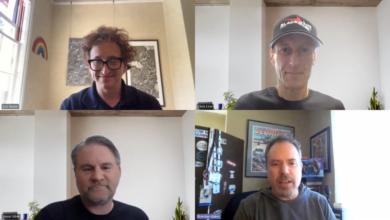THE BUSINESS OF RACING: BIG MONEY SPONSORSHIPS
Supercross is the area of motorcycle racing that has seen the biggest growth over the last 10 years in terms of exposure, sponsorships and level of competition.
“With supercross, we’ve transcended the bounds of the normal motorcycle enthusiast,” notes Gary Christopher, Honda’s senior manager of motorcycle press and motorcycle sports.
“While the bulk of the crowd is certainly core enthusiasts, there are significant numbers of people who come out to watch supercross who are not necessarily motorcycle enthusiasts.”
How did supercross attract those non-enthusiasts? Many say the magnet was a hot-shot rider named Jeremy McGrath riding in the early to mid-1990s. “Early in the McGrath era was really a watershed moment when supercross started to consistently draw good attendance,” says John Farris, vice president of commercial development for AMA Pro Racing.
“He put the whole thing into the mainstream,” notes Larry Brooks, the race team manager for Red Bull KTM. Not only did McGrath possess the skills to win races week after week, he possessed the character and charisma that pushed his motorcycle greatness beyond his built-in fan base and into mainstream America.
“Jeremy McGrath was the dominant rider during the period of time that Supercross was gaining more popularity with mainstream audiences,” says Farris. “As a result, many of our (AMA Pro Racing and the promoter) media inquiries were directed to Jeremy and he was always very accommodating to these requests. Even though he was completely dominating the racing, during interviews and one-on-one exchanges with fans he gave off a great vibe that was humble, appreciative, and interesting in a California-cool kind of way.”
PACE Motor Sports, the promoter at the time, saw the potential in bringing these exciting races and its new star to mainstream audiences.
“The promoter got the ball rolling,” says Farris. I would have to give credit to them for recognizing the potential. It started with a good race product that became amplified, if you will, by the promoter organizing more aspects of the event.”
WHAT’S THE ATTRACTION?
In terms of attracting sponsors, Farris says Supercross is, “much easier to sell and is an easier presentation of the product.”
For fans, supercross is a family-friendly sport with easy access. Stadiums are in urban areas, which are more accessible to the masses. The seating area is cleaner and often weatherproof than the series’ outdoor counterpart, motocross.
Christopher adds, “The paddock scene all afternoon preceding a supercross race is just wonderful. Folks can interact with the racers and see all the excitement there. There are displays set up to sell merchandise, plus there are demonstrations going on for something like trials riding or BMX riding.”
Helping to elevate the sport to new heights was improved television coverage. Supercross races on ESPN2 moved from not-so-favorable time slots like late at night or early morning, to easy-to-find regular weekend programming.
The presentation of the races improved as well, convincing ABC, the parent company of ESPN, to broadcast coverage of the Dallas Supercross in April of 1998 to a potential audience of 97 million television households. It was the first national broadcast of the AMA Supercross series in nearly two decades.
In 1998, PACE Motorsports evolved into SFX Entertainment, which then evolved into Clear Channel Entertainment by 2000, now the promoter of the entire supercross championship series. AMA Pro Racing grants a license to Clear Channel to promote the series.
Adding an increased level of credibility and professionalism was the formation of AMA Pro Racing in 1996. “What that did was allow the AMA to assign an executive in charge of running a very complicated and dynamic part of their business at the time. Prior to that it was a department of the AMA,” explains Farris.
Farris is the man in charge of developing corporate sponsorship deals for the AMA racing series. While improved television packaging made supercross more appealing to go after mainstream sponsors, Farris says, it’s never an easy sell. “In most cases, in order to get a deal sold at a major company, there has to be somebody inside the company or perhaps at their agency who really understands the motorcycle demographic and is passionate about it. If you look at the pure numbers, while it’s an appealing demographic or target market to a variety of brands it’s really not on the radar screen as an option for many of them. You have to sell it on what the true benefit is.”
For the last five years Chevrolet has been the title sponsor of the AMA superbike and motocross series. Progressive Insurance sponsors the flat track series, and Pace American Trailers is behind the hill climb series.
Clear Channel is responsible for bringing in the supercross series’ title sponsor, home video game producer THQ. It was a strategic move, says Farris. “THQ is taking the sport to the mass market through the marketing of video games. They’ve exposed the sport to hundreds of thousands of game players who may not otherwise be familiar with the sport of supercross.”
Now, from January to September, broadcasts of supercross and motocross races on ESPN2 attract 300,000 viewers each, equating to millions of viewers over the course of a race season. Both series are broadcast internationally to 90 million homes worldwide.
And, motocross is improving its game as a result of the increase in public awareness of its sister series, supercross. “The good news is that we’re seeing a real effort on the part of the promoters of our outdoor motocross series to improve the show there, and essentially to improve the facilities to make them fan friendly and to think about activities that can also draw families for an afternoon that is great,” says Christopher.
FUELING THE GROWTH OF RIDING
All this exposure has elevated supercross to unprecedented levels in terms of the sponsorship deals both from outside companies as well as from those inside the industry.
In 1995, aftermarket distributor Parts Unlimited signed on as a sponsor of the supercross races. Signs with the company’s logo were all over the stadium including the hay bales that line the dirt course. Greg Blackwell, Parts Unlimited’s vice president of sales, says the excitement of supercross helped fuel the double-digit sales growth the motorcycle industry has experienced over the last decade.
Parts Unlimited sponsors nearly every national professional motorcycle racing series. In 2004, the Janesville, Wisc.,-based aftermarket distributor signed on to sponsor the All Harley Drag Racing Association (AHDRA) under it’s V-twin aftermarket subsidiary Drag Specialties. Parts also sponsors two road racing teams and a long list of racers. “Racing is a big part of our promotions, and it is a very big part of our philosophy which we started many years ago, that is ‘We support the sport,’” says Blackwell.
The philosophy at Parts Unlimited has always been about putting money back into the sport. “If the sport grows, and we believe racing is a very large part of being a motorcycle enthusiast, people are going to get excited. We feel if ,we’re putting money into racing, the racing will be better; there will be money to put into the racers to put on a better show to get more people in the grandstands. More fans come out – whether they’re an enthusiast or deciding to be an enthusiast – they’re going to visit their powersports dealership to buy product.”
OEM SPONSORSHIP
As the racing scene has grown it’s forced the manufacturers to improve their race programs. “The OEMs have continued to invest more and more into the professionalism of it,” observes Farris. “That’s why there are semi-trailers at the race. Every rider who makes a main event has some affiliation with one of the factories. They’ve really elevated the sport in terms of the participants.”
Racing is big business for the OEMs, all of whom sponsor a factory supercross and motorcross team. Larry Brooks, KTM’s race team manager, says the Austrian company will spend upwards of $5 million a year on it supercross and motocross teams, and KTM is a relative newcomer to the AMA off-road circuit having entered it in 2001. “We wanted market share, what everyone wants. The whole goal in sponsoring a race team is positive advertisement and to overtake some of the market share.”
KTM has proven a worthy opponent against the more established OEM-sponsored teams. It won the 125 motocross championship in 2003.
How does a win like that translate to sales? “It’s really difficult to track that. I would see it as just trying to improve the image of the company. In people’s eyes, the win puts KTM in a bright light. They think ‘these people are supporting the sport, a sport we love so we will support them.’”
For all the money that’s put out into a racing effort, Brooks says, “You hope your profit is greater than your outgoing bills. If you’re spending all this money and you’re not getting results, obviously there’s a problem.”
From a newcomer to a veteran – for Honda, racing is “part of the company’s DNA,” says Christopher. “Racing improves the product. Many innovations in racing find their way into production vehicles. We also race for the image of our company.”
In the business of racing every entity needs each other to keep the wheels spinning. “It’s not about us getting the most lucrative sponsorship deals,” explains Farris. “We need all of our race teams to be properly funded so they can continue to elevate their professionalism. The way to do that is finding sponsors that not only invest in the sport itself but also take the sport to other markets and promote their involvement with the sport. It’s really about raising the whole level of revenue participation from everybody involved with the sport.” PSB
– Genevieve Schmitt








